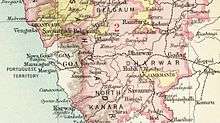Sawantwadi State
Savantvadi State, also spelt Sawantwadi ruled by the Sawant Bhonsale dynasty was one of the non-salute Maratha princely states during the British Raj. It was the only state belonging to the Kolaba Agency under the Bombay Presidency, which became later part of the Deccan States Agency.[1] Its capital was at Sawantwadi, in the present-day Sindhudurg district of Maharashtra.
| Savantvadi State | |||||||||
|---|---|---|---|---|---|---|---|---|---|
| Princely State of British India | |||||||||
| 1627–1948 | |||||||||
 Flag
 Coat of arms
| |||||||||
 Sawantwadi 1896 | |||||||||
| Area | |||||||||
• 1931 | 2,396 km2 (925 sq mi) | ||||||||
| Population | |||||||||
• 1931 | 250,589 | ||||||||
| History | |||||||||
• Established | 1627 | ||||||||
• Independence of India | 1948 | ||||||||
| |||||||||
| Today part of | Maharashtra, India | ||||||||

Sawantvadi State measured 438 square kilometers in area. According to the 1931 census, the population was 250,589. The main language of the inhabitants of the state was Marathi.[2]
History
The ancestor of Sawantwadi state, Mangal or Mang Sawant came to this area of South Konkan along with the army of Bijapur around 16th Century to serve as a Subhedar. He belonged to the Sisodia family from Udaipur.
Sawantwadi state was founded in 1627 by Khem Sawant I, later becoming a vassal state of the Sultanate of Bijapur. Khem Sawant II made Sundarwadi his capital which later got the name of Sawantwadi as the rulers were known as Sawants.
It had some fortified hills, such as Manohar and Mansantosh. On 7 April 1765 Savantvadi State became a British protectorate.
Sawantwadi acceded to the Dominion of India on 15 August 1947, becoming part of Bombay State in 1948.
Rulers
The rulers of Sawantvadi State were Hindu and belonged to the Sawant Bhonsle clan. They used the title of Raja Bahadur from 1785 onwards, a hereditary title granted to the head of the family by Shah Alam II.
Title Raja Sar Desai
- 1675 – Feb 1709 Khem Savant II Bhonsle (b. 16.. – d. 1709)
- Feb 1709 – 2 Jan 1738 Phond Savant II Bhonsle (b. 1667 – d. 1738)
- 2 Jan 1738 – 1755 Ramachandra Savant I Bhonsle (b. 1712 – d. 1755)
- 2 Jan 1738 – 1753 Jayram Sawant Bhonsle – Regent (d. 1753)
- 1755 – 1763 Khem Savant III Bhonsle (b. 1749 – d. 1803)
- 1755 – 1763 Soubhagyavati Janaki Bai Bhonsle (f) – Regent
Title Raja Bahadur
- 1763 – 6 Oct 1803 Khem Savant III (s.a.)
- 6 Oct 1803 – 1805 Rani Lakshmi Bai (f) – Regent (b. 17.. – d. 1807)
- 1805 – 1807 Ramachandra Savant II "Bhau Saheb" (b. 17.. – d. 1809)
- 1807 – 1808 Phond Savant II (d. 1808)
- 1808 – 3 Oct 1812 Phond Savant III (b. 17.. – d. 1812)
- 1807 – 1808 Rani Durga Bai (f) – Regent (d. 1819) (1st time)
- 3 Oct 1812 – 1867 Khem Savant IV "Bapu Saheb" (b. 1804 – d. 1867)
- 3 Oct 1812 – 28 Dec 1818 Rani Durga Bai (f) – Regent (s.a.) (2nd time)
- 28 Dec 1818 – 11 Feb 1823 Regents
- – Rani Savitri Bai Raje (f)
- – Rani Narmada Bai (f) (b. 1783 – d. 1849)
- 1867 – 7 Mar 1869 Phond Savant IV "Bapu Saheb" (b. 1828 – d. 1869)
- 7 Mar 1869 – Dec 1899 Raghunath Savant "Baba Saheb" (b. 1862 – d. 1899)
- 7 Mar 1869 – c.1880 .... -Regent
- Dec 1899 – 23 Apr 1913 Shriram Savant "Aba Saheb" (b. 1871 – d. 1913)
- Dec 1899 – 17 Jun 1900 .... -Regent
- 24 Apr 1913 – 4 Jul 1937 Khem Savant V "Bapu Saheb" (b. 1897 – d. 1937) (from 4 Jun 1934, Sir Khem Savant V)
- (Eldest Son of Khem Savant went to England Radhakrishna Samant (Savant)) lost claim to throne
- 24 Apr 1913 – 29 Oct 1924 Rani Gajara Bai Raje (f) – Regent (b. 1887 – d. 19..)
- 4 Jul 1937 – 15 Aug 1947 Shivramraje Savant Bhonsle (b. 1927 – d. 1995)
- 4 Jul 1937 – 12 May 1947 Rani Parvati Bai Raje (f) – Regent (b. 1907 – d. 1961)
The Present Head of the family is His Highness Khem Sawant VI. The erstwhile royal family is now striving hard to promote and carry forward the legacy of art of Ganjifa and Lacquer ware which was once revived by His Highness Lt. Col. Shivramraje Sawant Bhonsle and Her Highness Satvashiladevi Bhonsle in the Sawantwadi Palace. They are also coming up with a boutique hotel whose centre theme revolves around the Dashavtar Ganjifa.
See also
References
- Imperial Gazetteer of India, Oxford: Clarendon Press, 1908
- Great Britain India Office. The Imperial Gazetteer of India. Oxford: Clarendon Press, 1908.
External links
- . Encyclopædia Britannica. 24 (11th ed.). 1911. p. 247.